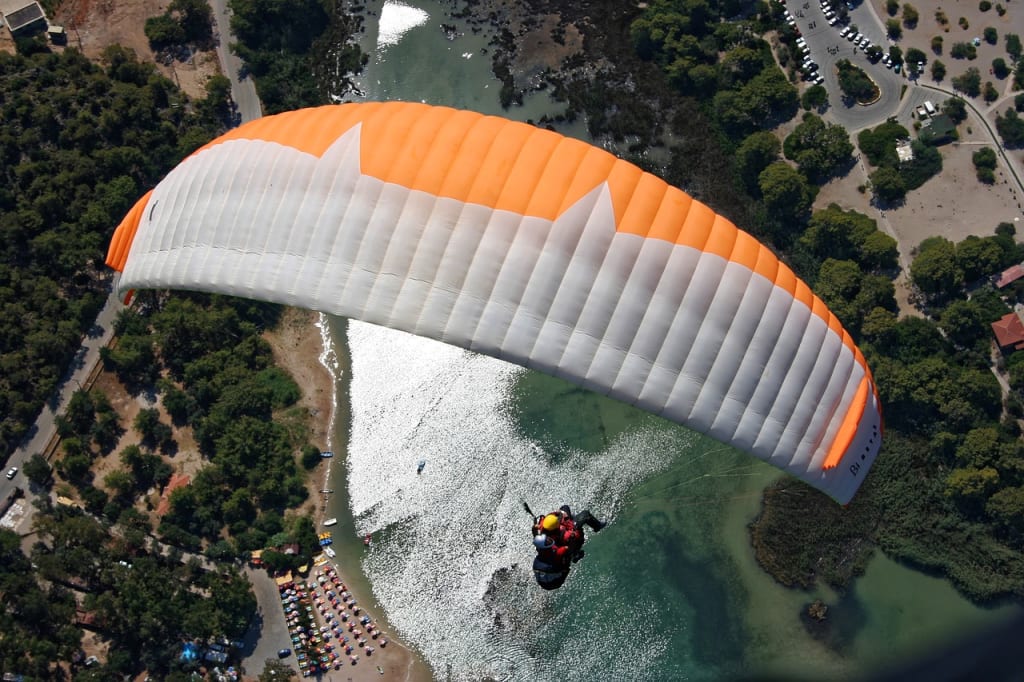Everything you need to know about Paragliding
Training, equipment, terminology, launch sites and much more.

If you are interested in learning Paraglide, then there are some basic steps and procedures. Let's check out the process of learning paragliding and we will also learn some tips for the beginners as well.
Get Paragliding Training
Paragliding training typically involves a combination of ground school and practical training. Ground school covers the basics of paragliding, including weather, aerodynamics, and safety. Practical training involves actually launching, flying, and landing a paraglider under the supervision of a certified instructor.
The process typically begins with a beginner course, which covers the basics of paragliding. This includes learning how to launch, fly, and land safely. The next step is typically an intermediate course, which covers more advanced flying techniques and prepares students for solo flights.
After completing an intermediate course, students can take an advanced course to learn advanced flying techniques such as thermal flying and cross-country flying.
It is important to note that paragliding is a weather dependent sport, and training may be delayed or rescheduled due to inclement weather conditions. Also, it's important to find a reputable and certified paragliding school to ensure that you receive proper training and instruction.
Learn Paragliding Terminology
During your training process you should learn the paragliding specific terminology and should keep the terms in your mind. This is very important to know the terms related to paragliding.
- Airspeed: The speed at which a paraglider is traveling through the air.
- Ascent: The upward movement of a paraglider.
- Brakes: The control lines used to control the speed and direction of a paraglider.
- Canopy: The fabric portion of a paraglider that provides lift.
- Descent: The downward movement of a paraglider.
- Glide Ratio: The ratio of the distance a paraglider can travel forward to the altitude it loses during descent.
- Harness: The device that connects a paraglider to the pilot.
- Launch: The process of getting a paraglider into the air.
- Luffing: When a paraglider loses its shape and loses lift.
- Ridge Soaring: Flying along a ridge or hill using the upward air currents.
- Sink rate: The rate at which a paraglider is losing altitude.
- Stall: A condition in which a paraglider loses lift and begins to descend.
- Thermal: A column of rising air that can be used by a paraglider to gain altitude.
- Trim: The adjustment of a paraglider's speed and direction.
- Upwind: The direction from which the wind is blowing.
- Wing loading: The weight of the pilot and equipment divided by the wing area of the paraglider.
Find a Perfect Launch Site for Paragliding
A launch site for paragliding is typically a hill or mountain with a clear, open area that is suitable for paragliding. The site should have a good wind direction and should be free of obstacles such as trees, power lines, and buildings.
There are two types of launch sites: flatland and mountainous. Flatland launch sites are typically located in open fields or parks, while mountainous launch sites are located on the side of a hill or mountain.
When choosing a launch site, it's important to consider the wind direction and strength. A good launch site should have a consistent wind direction and strength that will allow for a smooth and safe launch. It's also important to consider the landing area, which should be a clear, open area that is free of obstacles.
It's also important to note that some launch sites may require a permit, or might be restricted for certain days of the week or during specific hours. It's important to check the rules and regulations of the launch site before paragliding.
Here you can find out the best and most popular spots for paragliding in US.
How to Set up Your Equipment for Paragliding
- Lay out your equipment: Before setting up your equipment, it's important to lay out all of the components on the ground. This will make it easier to check for any missing or damaged parts.
- Attach the paraglider to the harness: The first step in setting up your equipment is to attach the paraglider to the harness. This typically involves connecting the risers to the harness and the lines to the risers.
- Check the lines: After connecting the lines to the risers, it's important to check for any knots or tangles in the lines. Make sure that all the lines are free of knots and tangles before launching.
- Connect the brakes: The next step is to connect the brakes to the paraglider. This typically involves attaching the brake lines to the risers and the brake handles to the harness.
- Check the risers: After connecting the brake lines, it's important to check the risers for any knots or tangles. Make sure that the risers are free of knots and tangles before launching.
- Adjust the harness: Before launching, it's important to adjust the harness to ensure a comfortable fit. Make sure that the harness is snug but not too tight, and that the leg straps are adjusted to the correct length.
- Check the weather: Before launching, it's important to check the weather conditions. Make sure that the wind direction and strength are suitable for paragliding, and that the weather is safe for flying.
Perfect Weather for Paragliding
The perfect weather for paragliding is typically characterized by clear skies, light winds, and mild temperatures.
- The wind should be between 5-15 mph and should be blowing in the same direction across the launch and landing site. Stronger winds can make launching and landing difficult and dangerous.
- The sky should be clear with no clouds or thunderstorms nearby. Cloud cover can affect visibility and make flying difficult.
- Temperature should be comfortable for the pilot to fly, not too hot or too cold.
- It's also important to consider the humidity and air pressure. High humidity and low air pressure can affect the performance of the paraglider and make flying difficult.
It's important to note that weather conditions can change quickly, so it's always a good idea to check the forecast before launching and to be aware of any potential weather changes while flying.
It's also important to have a plan for dealing with unexpected weather changes, such as having a backup landing site or knowing how to safely land in a strong wind.





Comments
There are no comments for this story
Be the first to respond and start the conversation.